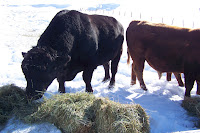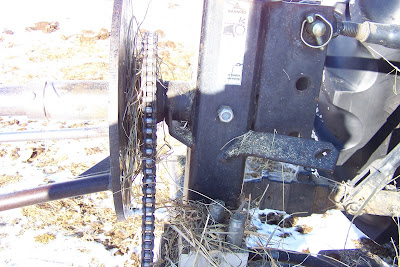 | |
| The twin we brought to the calf shed today. |
We were beginning to wonder if the cows in our breeding program were ever going to begin to calve. Four of the five bred cows we bought to replace cows we had to sell had already calved. The start date for our own cows was two days ago; but finally this morning at about 8 AM, the first cow of our herd presented us with not one but two calves. Twins can mean problems. Over the last decade, we seem to have more than our share of twins with the highest number of sets of twins at six, most years it has ranged between two and three sets, but never less than one set.
A dairy farmer selects breeds of cattle which produce a large quantity of good quality milk. A beef rancher selects breeds of cattle which will develop muscle with just the right amount of fat to provide high quality meat. We are concerned that a beef cow have a good mothering instinct and produce enough high quality milk to grow her calf and keep it healthy. While a beef cow may be able to produce enough milk for two calves, it usually is at the expense of her own physical condition. Through years of observation, we have noticed that our cows deal with twins in one of two ways. The first way is to feed the calf which is closest to her and demands food. I jokingly tell my friends that because a cow can't count to two, she feeds which ever calf is closest to her and doesn't realize that there are two different calves. In this instance, both calves become weak because neither gets adequate nourishment. The second way that a cow deals with twins is to pick one and refuse the other. From our observations, size, sex or strength don't have a baring on why a cow chooses one calf and refuses the other. That's a study for the scientists.
When we have a set of twins born here on the ranch we always remove one calf so that the cow will raise only one. This way the cow and the calf will both be strong. Usually, when twins are born, a cow will have the first calf, clean it off, get it to stand and feed; then after awhile, leaving her first calf , she will go off to a different part of the calving grounds to have her second calf which she will clean off, get it to stand, and feed it. It from this point that we spend the day watching to see how the cow will react to her twins. If the cow chooses one and refuses the other, it is easy to pick which one to pull (take away from its mother). If the cow is willing to feed both calves then we must make the choice for her. We usually pull the weaker or smaller calf. For whatever reason the calf is pulled from its mother, it then becomes a "Bucket" calf; it's called that because we use a one gallon blue bucket with a nipple to feed it. On some ranches where they use one gallon plastic bottles to feed the calf they're called bottle calves.
 |
| Measuring cups, bucket, colostrum, scale, whip, calculator, pen and paper are all used to make sure the calf gets what she needs. |
The mother of today's twins was one of those mothers who seemed okay with both calves. The smaller calf, a heifer, was born first and was an only calf for about two hours. This meant that she had a great start, was completely dry and had a good dose of her mother's colostrum. The cow went off to deliver her second calf. He too received a good tongue drying and a good dose of colostrum. This cow had a strong mothering instinct and took an pretty equal interest in both calves. We chose the smaller calf to bring up to calf shed.
Because there is so much snow that we can only get to the calving grounds with the tractor, there are two options for getting them up to the calf shed, inside the cab of the tractor or in the front end loader. If the calf is small enough, Jim lifts them up into the tractor's cab. Luckily, they're young enough that Jim can keep them lying down and still drive. If they're too big to lift into the cab of the tractor or too active, then Jim comes and gets me. We catch the calf and load it into the front end loader. Jim climbs in to hold the calf, I raise the front end loader and tip the bucket so that it is like a cradle for Jim and the calf. We drive out of the calving grounds and up the road to the house and calf shed in a procession with Fritz, our border collie, leading the way because he seems to act as if he is in charge of every calf we bring up to the shed.
The calf shed is actually a shed constructed in the 1940's that has been used for as a chicken house, 4-H pig house and storage. Currently, it is storage with one end where there are large windows and access to power sectioned off for the purpose of sheltering the bucket calves. Fresh hay is scattered thickly on the floor and a heat lamp is hung in one corner. We leave the calf alone.
 |
| Checking and warming the new nipple with water. |
 |
| Mixing the colostrum with the right temperature of water. |
When we teach the calf to nurse from the bucket, we stand the calf in a corner, Jim standing astraddle of it. I hold the bucket in front and gently press the nipple to the calve's lips. Jim opens the her mouth and I place the nipple on top of the tongue, hoping the calf will wrap its tongue around the nipple. Usually, Jim has to close the calve's mouth around the nipple and with his hand gently causes the calf to squeeze the nipple forcing milk into the calve's throat. If the calf resists this, Jim puts a finger inside the mouth pressing on the nipple causing it to squirt the milk into the calves mouth. The calf tries to back away but can't because we have it in a corner. After a few pumps, the calf has to swallow. If the calf doesn't swallow, I remove the nipple from the its mouth, Jim raises the calve's head and I gently stroke the outside of its throat which causes the calf to swallow. Most of the time, after the first few tries, the calf gets the idea and begins to suck on the nipple itself. Today's calf took only one try before she figured out how to get milk from the bucket. We'll have to put her in a corner every time we feed her, usually less than four times, until she starts coming to the blue bucket. From this point on, she will follow the blue bucket anywhere.
After we get her trained to use the bucket, we will find her a different home. We have three options. The first option is to take the calf to the grandchildren on the front range. At the ages of 7 and 8, they are old enough to do most of the care taking but will still need help with teaching her to lead and stand. They may decide to join the 4-H as Cloverbuds. Another option is to do what we did two years ago and find kid in 4-H here in Routt County who would like to raise the calf for a bucket calf project. Pee Wee the Wonder Calf is a story I wrote about our bucket calf of two years ago. The third option is to call our friend Nancy. She has cows which are half beef cows and half milk cows. These cows produce enough milk to grow two or three calves each. She has worked with them and has trained them to easily take orphan calves as their own. She buys twin calves or other orphaned calves for her cows now and sells them in the fall.
The twin calf which is still with its mother is doing very well, bouncing around but still staying close to his mother's side. He has received his number, 5. Another calf was born this afternoon and as the sun sets is up and going strong also. He is number 6. The twin that we have brought up to the calf shed will not receive a herd number. If the grandkids take her, she will get a herd number if they decide to sell her with our calves next fall; if they decide to sell her on their own she won't have a herd number. If someone in 4-H wants her for a project, we'll pay all of her expenses and give the one who cared for her all summer a percentage of her sale price so she'll get a herd number if she sells with our herd. If our friend Nancy takes her, she will get a herd number for Nancy's herd. We'll keep you informed.
 |
| The calf has learned to suck on her own but is still learning to stay attached to the bucket. |
Some books about this subject you might be interested in are:
Fiction books
Little Joe by Sandra Neil Wallace ( for third grade or higher) The story of a nine year old boy who raises a bucket calf for the fair.
Sugar Lump the Orphan Calf by Lynn Sheffield Simmons (for upper fifth grade or higher) This is a story of a 12 year old girl raising a bucket calf. This has a teacher's guide and discussion questions and activities at
Nonfiction books
Wow, It’s a Cow by Judy and Jay Harris (toddler to preschool)
Cows and Their Calves by Margaret Hall ( early elementary)
Cattle: Cows, Bulls and Calves on the farm by Lorijo Metz (elementary)
Fun and Silly Books
Only a Cow Lucy, the cow is looking for a more exciting life (preschool and early elementary)
























